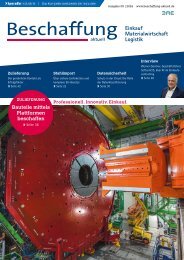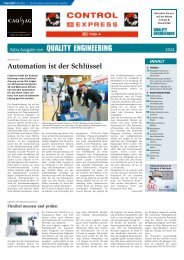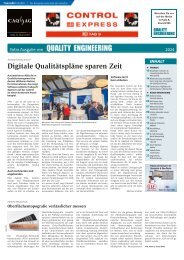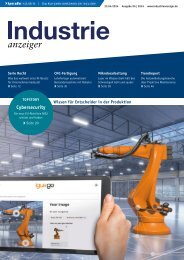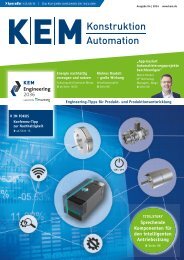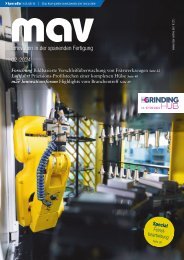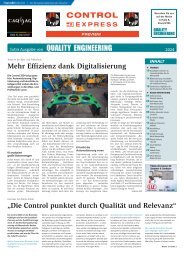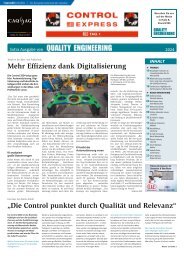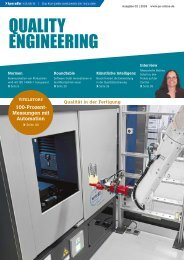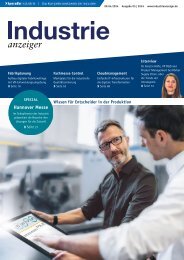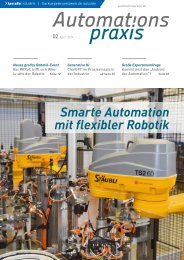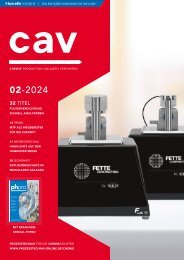EPP Europe P2.2022
Create successful ePaper yourself
Turn your PDF publications into a flip-book with our unique Google optimized e-Paper software.
Bild: Microcare<br />
Particulate contamination comes from the air,<br />
from the abrasion of moving parts, from clothing,<br />
or from dirty, unfiltered etching fluids<br />
(Metal Oxide Semiconductor Field-Effect<br />
Transistors) or other semiconductor components<br />
are immersed in the heated fluid<br />
for cleaning. Often, agitation helps enhance<br />
the cleaning fluid’s effectiveness.<br />
This is done by leveraging the boiling action<br />
of the cleaning fluid, adding vibrating<br />
ultrasonic energy or using a spray<br />
wand to loosen the particulate off the<br />
substrate. Once cleaned, the parts mechanically<br />
transfer to the rinse sump. The<br />
parts rinse in pure, uncontaminated fluid<br />
or inside the fluid vapors themselves. The<br />
components come out cool so they are<br />
immediately ready for use or for the next<br />
stage of processing. Unlike the commoner<br />
aqueous cleaning, vapor degreasing combines<br />
cleaning, rinsing and drying in one<br />
step to maximize takt time. It takes as<br />
little as 6–20 minutes per batch.<br />
Moreover, vapor degreasers typically<br />
have a smaller footprint than aqueous<br />
cleaners. The systems take up less valuable<br />
production space and, because vapor<br />
degreasing cleaning is a simple, predictable<br />
and repeatable process, it is easy to<br />
qualify and validate for cleanroom use.<br />
Good particle displacement<br />
The displacement cleaning fluids used<br />
inside vapor degreasers have chemical<br />
and physical properties that are advantageous<br />
to particle displacement and help<br />
accelerate the cleaning process. Small<br />
particles can be difficult to remove from<br />
wafers since strong electrostatic forces<br />
exist between the particles and the wafer<br />
substrate. A particle adheres to the substrate<br />
through adhesion forces, whether<br />
it is an electrostatic charge or Van der<br />
Waals force. This adhesion creates a friction<br />
force parallel with the surface: static<br />
friction if the particle is not moving, dynamic<br />
friction if it is. To remove the contaminant,<br />
the cleaning fluid must reduce<br />
the thickness of the laminar boundary<br />
layer, break the bond and allow the particles<br />
to release from the substrate.<br />
Some displacement fluids are a mixture<br />
of hydrofluoro-olefin (HFO) and ethanol<br />
that removes fine particulate down to the<br />
micron or even sub-micron range. The alcohol<br />
component forms hydrogen bonds<br />
at the fluid-substrate interface, reducing<br />
the intermolecular forces between the<br />
particle and the substrate. This allows the<br />
particulate to lift more easily from the<br />
substrate.<br />
Plus, the fluorocarbon-based fluids are<br />
synthetically derived, allowing for a<br />
higher purity level than traditional hydrocarbon-based<br />
cleaning fluids. These<br />
ultra-pure fluids dry quickly and completely<br />
without leaving spots or residue<br />
behind.<br />
High density & low viscosity<br />
Particulate displacement fluids are<br />
dense: typically, 20–40% heavier than<br />
water and 50% heavier than alcohol.<br />
They also have a lower viscosity than IPA<br />
(Isopropyl Alcohol), water or water with<br />
surfactant additives. The combination of<br />
the higher density and the lower viscosity<br />
About the author<br />
Elizabeth Norwood is a<br />
Senior Chemist at MicroCare,<br />
which offers precision cleaning<br />
solutions. She has been in<br />
the industry more than 25<br />
years and has a BS in Chemistry<br />
from the University of St.<br />
Joseph. Norwood researches,<br />
develops and tests cleaningrelated<br />
products. She currently<br />
has one patent issued<br />
and two pending for her<br />
work. For more information,<br />
visit www.microcare.com.<br />
THE FLEXIBILITY<br />
FOR MASS<br />
INTERCONNECT<br />
ODU-MAC ®<br />
GET YOUR<br />
SOLUTION<br />
NOW!<br />
black-line@odu.de<br />
Electromechanical version<br />
Eight tensioning points<br />
for equal connections<br />
Flexible configuration with<br />
ODU-MAC® modules<br />
Including cable assembly<br />
www.odu.de<br />
<strong>EPP</strong> <strong>Europe</strong> » 11 | 2022 23



